Statistics for Management: Statistical Methods and Data Analysis
VerifiedAdded on 2023/02/02
|21
|3384
|97
Homework Assignment
AI Summary
This assignment on Statistics for Management delves into the application of statistical tools and techniques to interpret business dynamics. It examines business and economic data from published sources, analyzing raw data using various statistical methods. The report covers Consumer Price Indices (CPI, CPIH, RPI), their differences, and the importance of inflation rates. It also includes data evaluation using bar charts and scatter diagrams, exploring descriptive, exploratory, and confirmatory analysis. Furthermore, the assignment involves calculating and comparing statistical measures such as median, quartiles, mean, and standard deviation, along with a scatter diagram analysis of temperature and hot drink sales, including the calculation of the correlation coefficient. The assignment provides a comprehensive overview of statistical methods in a business context.
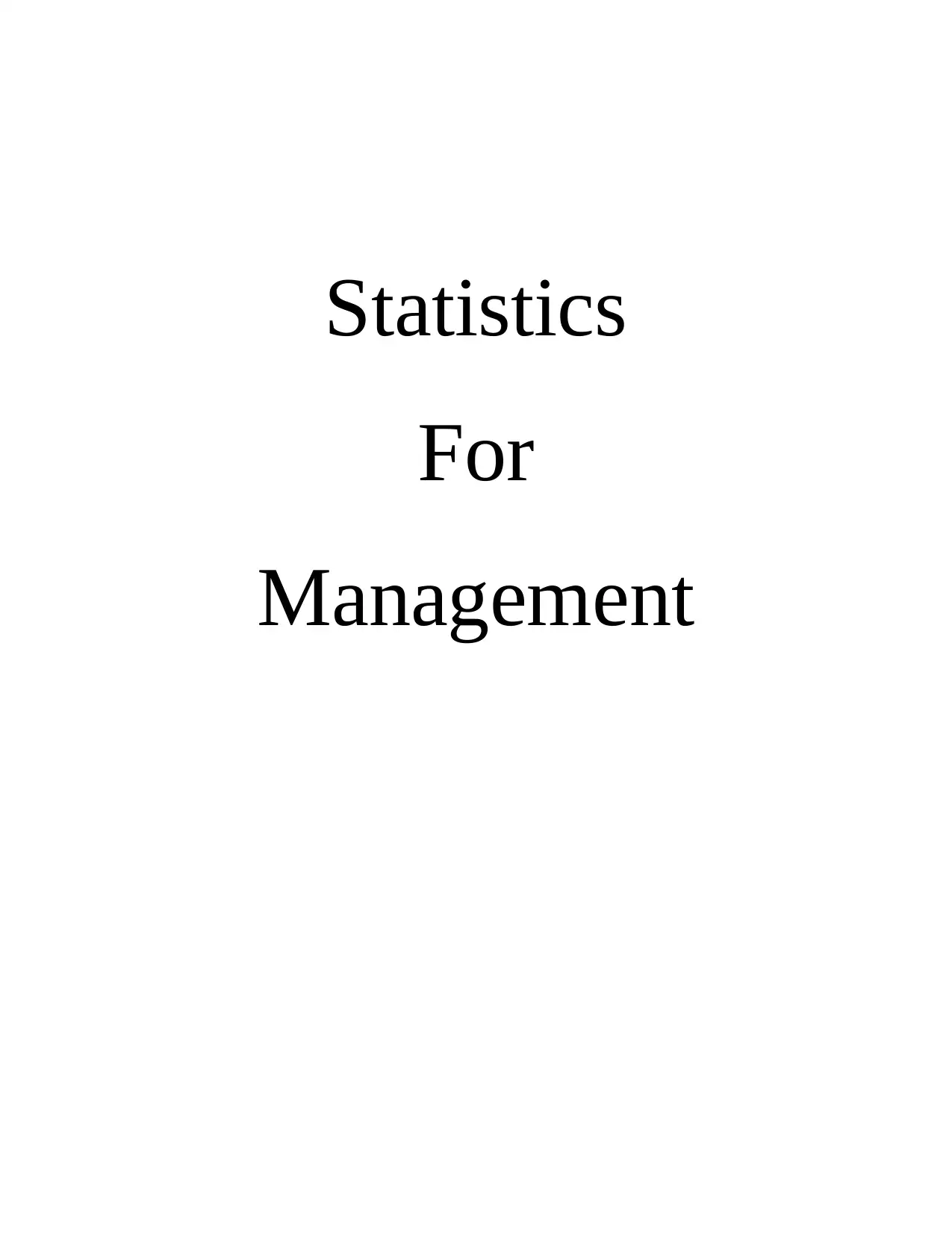
Statistics
For
Management
For
Management
Paraphrase This Document
Need a fresh take? Get an instant paraphrase of this document with our AI Paraphraser
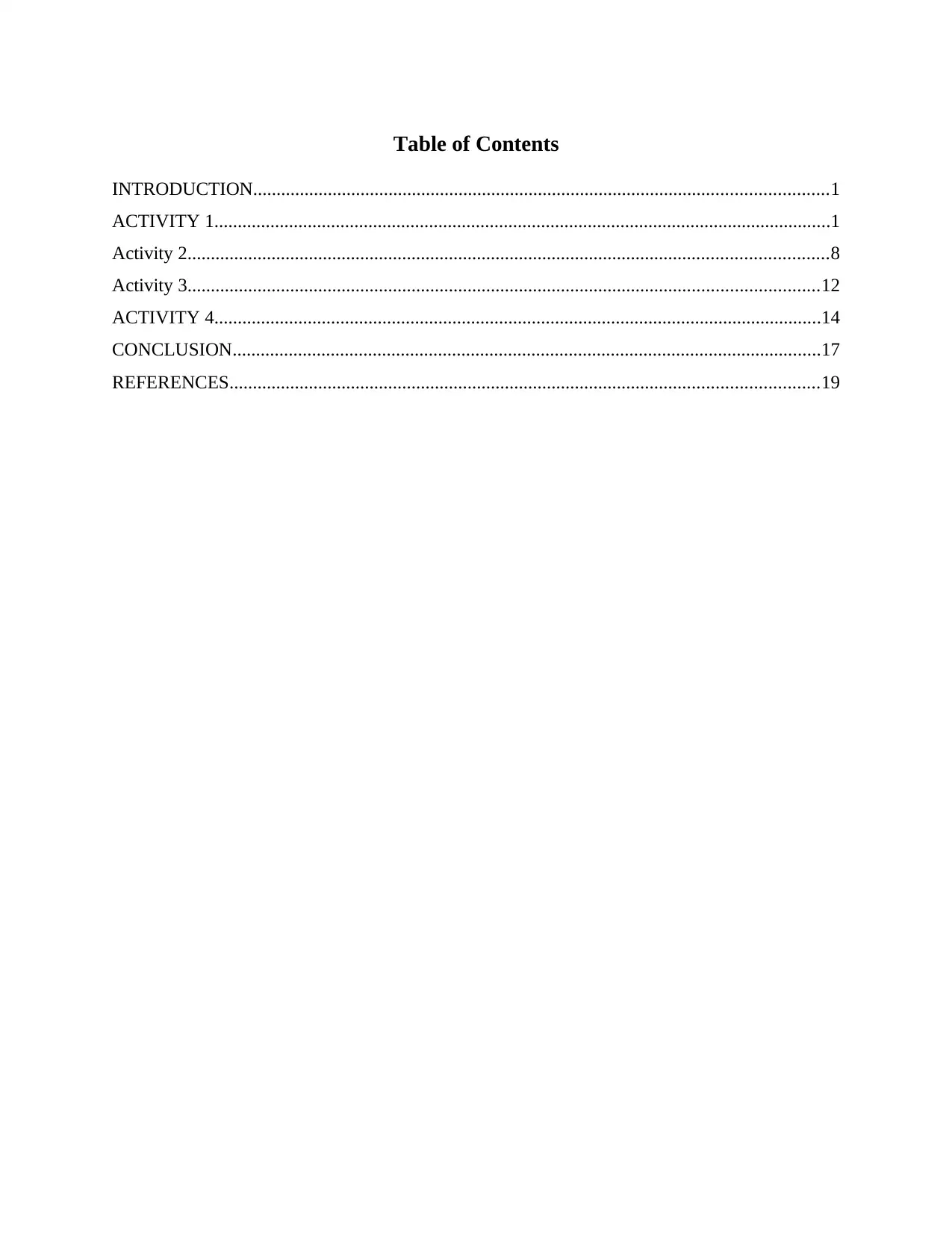
Table of Contents
INTRODUCTION...........................................................................................................................1
ACTIVITY 1....................................................................................................................................1
Activity 2.........................................................................................................................................8
Activity 3.......................................................................................................................................12
ACTIVITY 4..................................................................................................................................14
CONCLUSION..............................................................................................................................17
REFERENCES..............................................................................................................................19
INTRODUCTION...........................................................................................................................1
ACTIVITY 1....................................................................................................................................1
Activity 2.........................................................................................................................................8
Activity 3.......................................................................................................................................12
ACTIVITY 4..................................................................................................................................14
CONCLUSION..............................................................................................................................17
REFERENCES..............................................................................................................................19
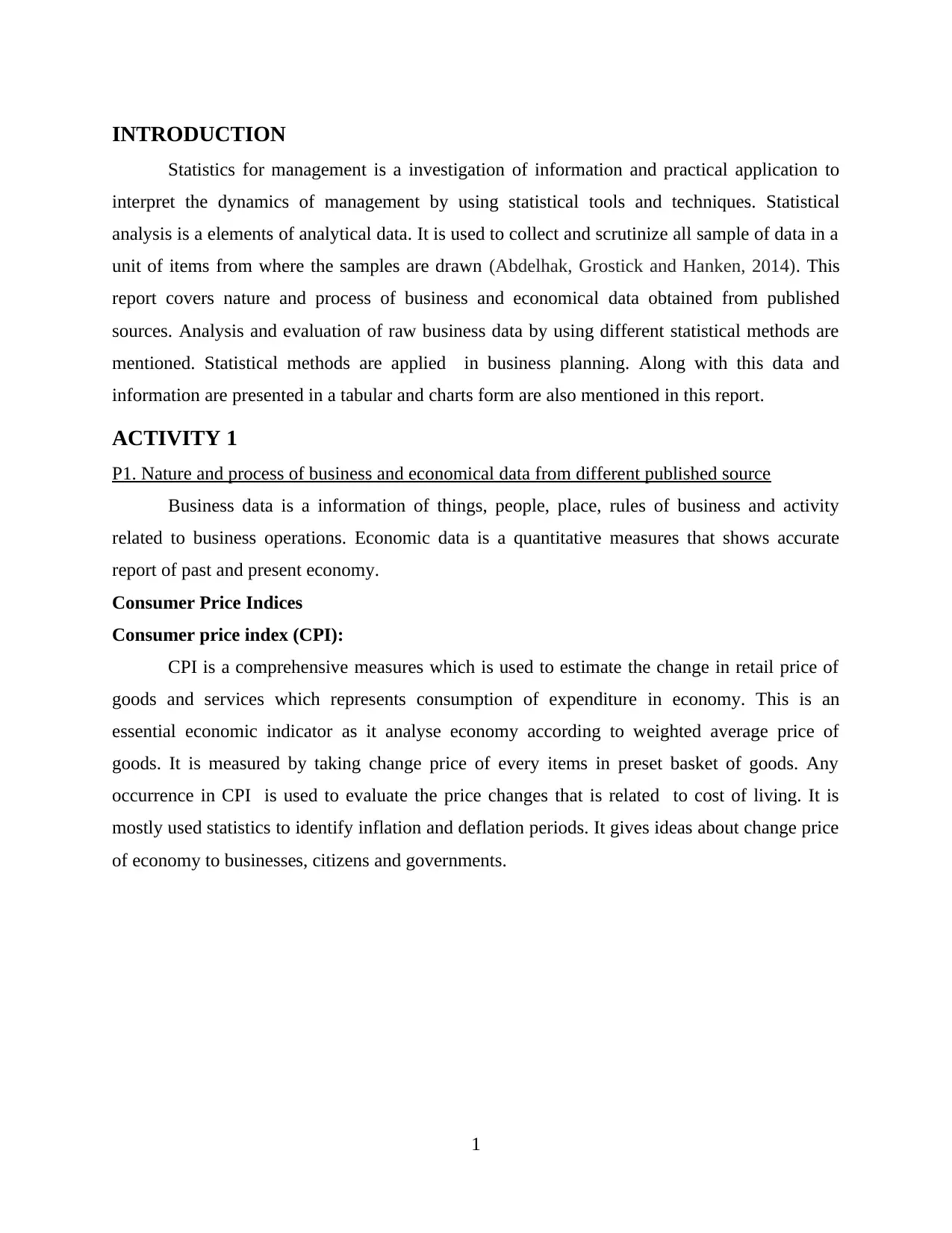
INTRODUCTION
Statistics for management is a investigation of information and practical application to
interpret the dynamics of management by using statistical tools and techniques. Statistical
analysis is a elements of analytical data. It is used to collect and scrutinize all sample of data in a
unit of items from where the samples are drawn (Abdelhak, Grostick and Hanken, 2014). This
report covers nature and process of business and economical data obtained from published
sources. Analysis and evaluation of raw business data by using different statistical methods are
mentioned. Statistical methods are applied in business planning. Along with this data and
information are presented in a tabular and charts form are also mentioned in this report.
ACTIVITY 1
P1. Nature and process of business and economical data from different published source
Business data is a information of things, people, place, rules of business and activity
related to business operations. Economic data is a quantitative measures that shows accurate
report of past and present economy.
Consumer Price Indices
Consumer price index (CPI):
CPI is a comprehensive measures which is used to estimate the change in retail price of
goods and services which represents consumption of expenditure in economy. This is an
essential economic indicator as it analyse economy according to weighted average price of
goods. It is measured by taking change price of every items in preset basket of goods. Any
occurrence in CPI is used to evaluate the price changes that is related to cost of living. It is
mostly used statistics to identify inflation and deflation periods. It gives ideas about change price
of economy to businesses, citizens and governments.
1
Statistics for management is a investigation of information and practical application to
interpret the dynamics of management by using statistical tools and techniques. Statistical
analysis is a elements of analytical data. It is used to collect and scrutinize all sample of data in a
unit of items from where the samples are drawn (Abdelhak, Grostick and Hanken, 2014). This
report covers nature and process of business and economical data obtained from published
sources. Analysis and evaluation of raw business data by using different statistical methods are
mentioned. Statistical methods are applied in business planning. Along with this data and
information are presented in a tabular and charts form are also mentioned in this report.
ACTIVITY 1
P1. Nature and process of business and economical data from different published source
Business data is a information of things, people, place, rules of business and activity
related to business operations. Economic data is a quantitative measures that shows accurate
report of past and present economy.
Consumer Price Indices
Consumer price index (CPI):
CPI is a comprehensive measures which is used to estimate the change in retail price of
goods and services which represents consumption of expenditure in economy. This is an
essential economic indicator as it analyse economy according to weighted average price of
goods. It is measured by taking change price of every items in preset basket of goods. Any
occurrence in CPI is used to evaluate the price changes that is related to cost of living. It is
mostly used statistics to identify inflation and deflation periods. It gives ideas about change price
of economy to businesses, citizens and governments.
1
⊘ This is a preview!⊘
Do you want full access?
Subscribe today to unlock all pages.

Trusted by 1+ million students worldwide
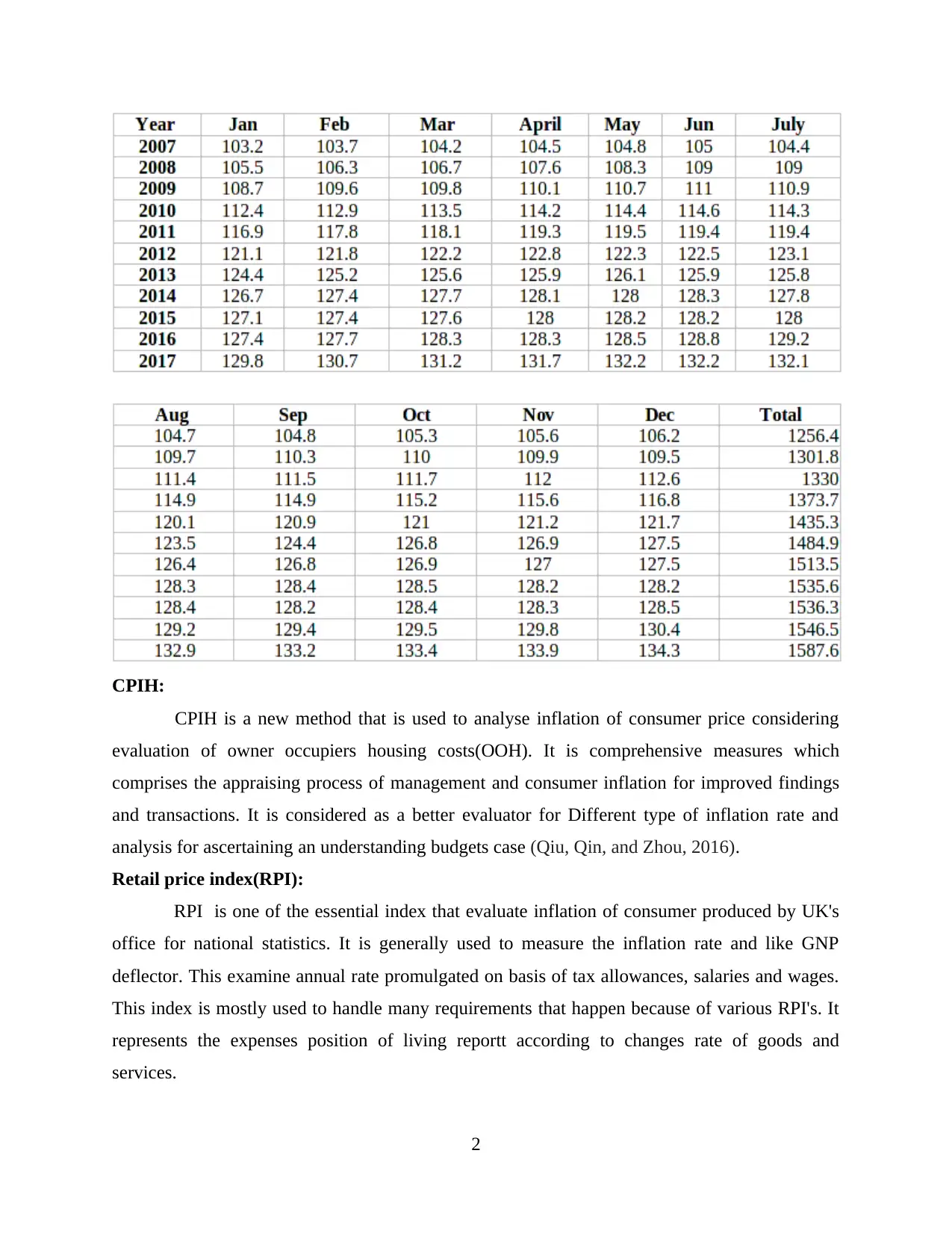
CPIH:
CPIH is a new method that is used to analyse inflation of consumer price considering
evaluation of owner occupiers housing costs(OOH). It is comprehensive measures which
comprises the appraising process of management and consumer inflation for improved findings
and transactions. It is considered as a better evaluator for Different type of inflation rate and
analysis for ascertaining an understanding budgets case (Qiu, Qin, and Zhou, 2016).
Retail price index(RPI):
RPI is one of the essential index that evaluate inflation of consumer produced by UK's
office for national statistics. It is generally used to measure the inflation rate and like GNP
deflector. This examine annual rate promulgated on basis of tax allowances, salaries and wages.
This index is mostly used to handle many requirements that happen because of various RPI's. It
represents the expenses position of living reportt according to changes rate of goods and
services.
2
CPIH is a new method that is used to analyse inflation of consumer price considering
evaluation of owner occupiers housing costs(OOH). It is comprehensive measures which
comprises the appraising process of management and consumer inflation for improved findings
and transactions. It is considered as a better evaluator for Different type of inflation rate and
analysis for ascertaining an understanding budgets case (Qiu, Qin, and Zhou, 2016).
Retail price index(RPI):
RPI is one of the essential index that evaluate inflation of consumer produced by UK's
office for national statistics. It is generally used to measure the inflation rate and like GNP
deflector. This examine annual rate promulgated on basis of tax allowances, salaries and wages.
This index is mostly used to handle many requirements that happen because of various RPI's. It
represents the expenses position of living reportt according to changes rate of goods and
services.
2
Paraphrase This Document
Need a fresh take? Get an instant paraphrase of this document with our AI Paraphraser
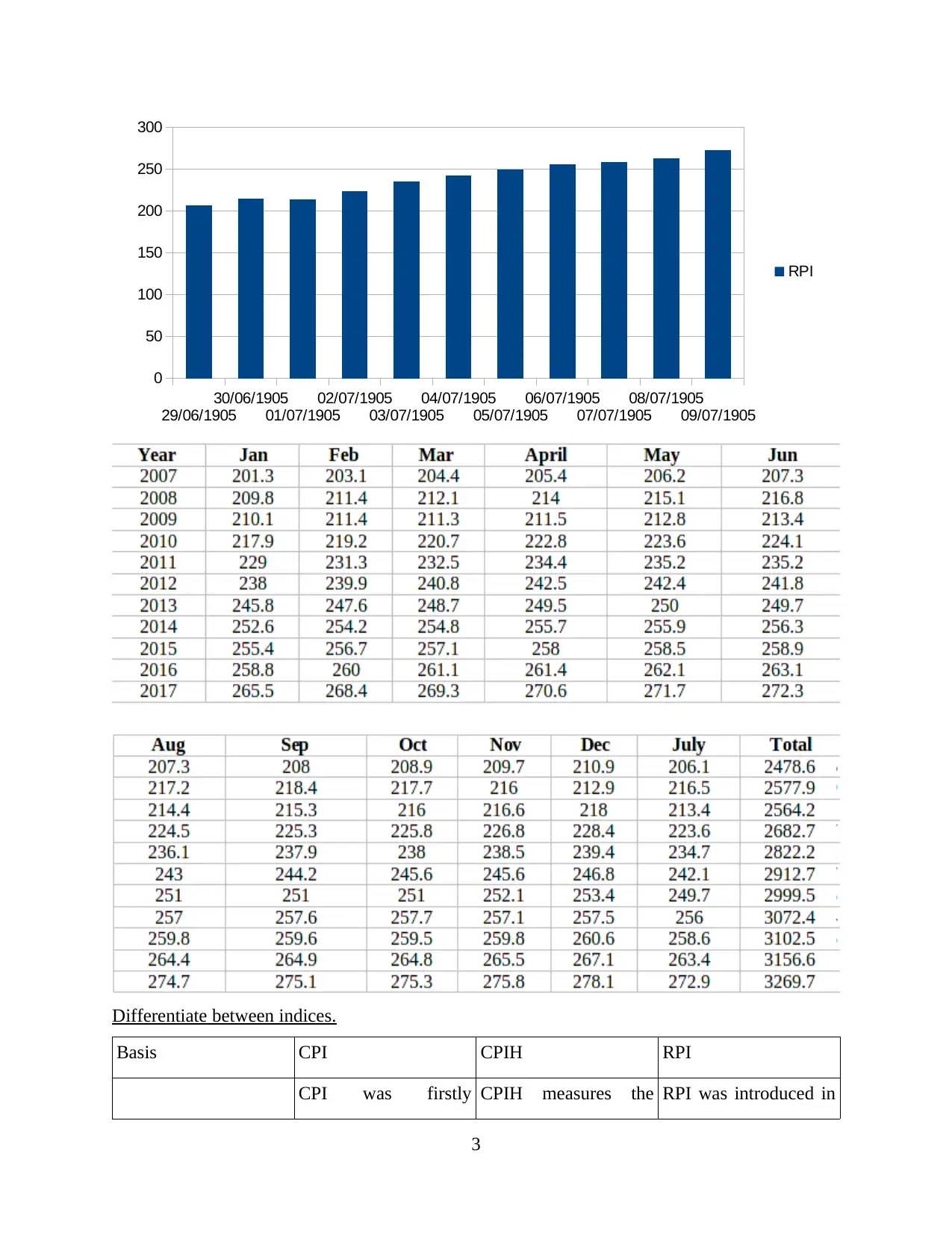
Differentiate between indices.
Basis CPI CPIH RPI
CPI was firstly CPIH measures the RPI was introduced in
3
29/06/1905
30/06/1905
01/07/1905
02/07/1905
03/07/1905
04/07/1905
05/07/1905
06/07/1905
07/07/1905
08/07/1905
09/07/1905
0
50
100
150
200
250
300
RPI
Basis CPI CPIH RPI
CPI was firstly CPIH measures the RPI was introduced in
3
29/06/1905
30/06/1905
01/07/1905
02/07/1905
03/07/1905
04/07/1905
05/07/1905
06/07/1905
07/07/1905
08/07/1905
09/07/1905
0
50
100
150
200
250
300
RPI
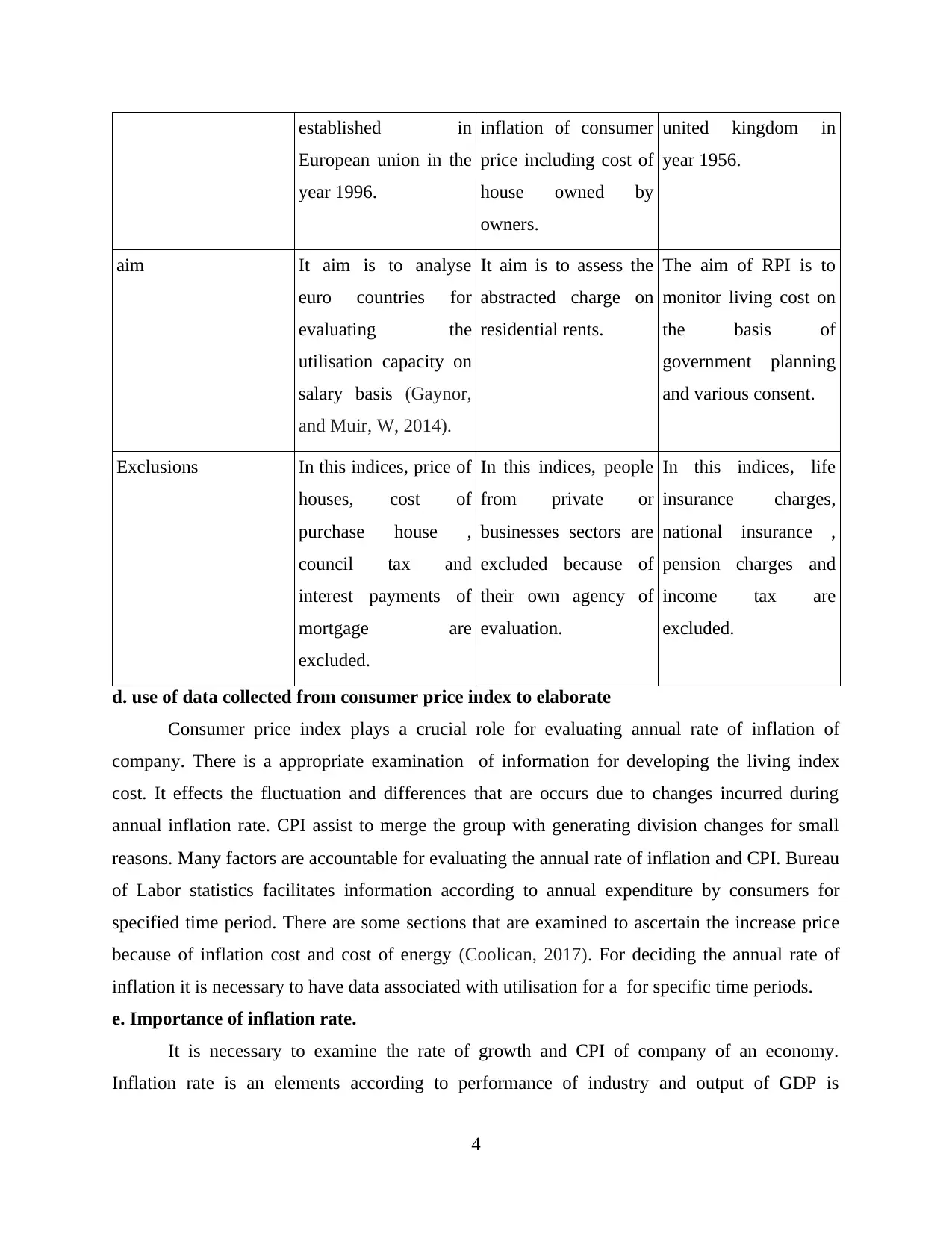
established in
European union in the
year 1996.
inflation of consumer
price including cost of
house owned by
owners.
united kingdom in
year 1956.
aim It aim is to analyse
euro countries for
evaluating the
utilisation capacity on
salary basis (Gaynor,
and Muir, W, 2014).
It aim is to assess the
abstracted charge on
residential rents.
The aim of RPI is to
monitor living cost on
the basis of
government planning
and various consent.
Exclusions In this indices, price of
houses, cost of
purchase house ,
council tax and
interest payments of
mortgage are
excluded.
In this indices, people
from private or
businesses sectors are
excluded because of
their own agency of
evaluation.
In this indices, life
insurance charges,
national insurance ,
pension charges and
income tax are
excluded.
d. use of data collected from consumer price index to elaborate
Consumer price index plays a crucial role for evaluating annual rate of inflation of
company. There is a appropriate examination of information for developing the living index
cost. It effects the fluctuation and differences that are occurs due to changes incurred during
annual inflation rate. CPI assist to merge the group with generating division changes for small
reasons. Many factors are accountable for evaluating the annual rate of inflation and CPI. Bureau
of Labor statistics facilitates information according to annual expenditure by consumers for
specified time period. There are some sections that are examined to ascertain the increase price
because of inflation cost and cost of energy (Coolican, 2017). For deciding the annual rate of
inflation it is necessary to have data associated with utilisation for a for specific time periods.
e. Importance of inflation rate.
It is necessary to examine the rate of growth and CPI of company of an economy.
Inflation rate is an elements according to performance of industry and output of GDP is
4
European union in the
year 1996.
inflation of consumer
price including cost of
house owned by
owners.
united kingdom in
year 1956.
aim It aim is to analyse
euro countries for
evaluating the
utilisation capacity on
salary basis (Gaynor,
and Muir, W, 2014).
It aim is to assess the
abstracted charge on
residential rents.
The aim of RPI is to
monitor living cost on
the basis of
government planning
and various consent.
Exclusions In this indices, price of
houses, cost of
purchase house ,
council tax and
interest payments of
mortgage are
excluded.
In this indices, people
from private or
businesses sectors are
excluded because of
their own agency of
evaluation.
In this indices, life
insurance charges,
national insurance ,
pension charges and
income tax are
excluded.
d. use of data collected from consumer price index to elaborate
Consumer price index plays a crucial role for evaluating annual rate of inflation of
company. There is a appropriate examination of information for developing the living index
cost. It effects the fluctuation and differences that are occurs due to changes incurred during
annual inflation rate. CPI assist to merge the group with generating division changes for small
reasons. Many factors are accountable for evaluating the annual rate of inflation and CPI. Bureau
of Labor statistics facilitates information according to annual expenditure by consumers for
specified time period. There are some sections that are examined to ascertain the increase price
because of inflation cost and cost of energy (Coolican, 2017). For deciding the annual rate of
inflation it is necessary to have data associated with utilisation for a for specific time periods.
e. Importance of inflation rate.
It is necessary to examine the rate of growth and CPI of company of an economy.
Inflation rate is an elements according to performance of industry and output of GDP is
4
⊘ This is a preview!⊘
Do you want full access?
Subscribe today to unlock all pages.

Trusted by 1+ million students worldwide
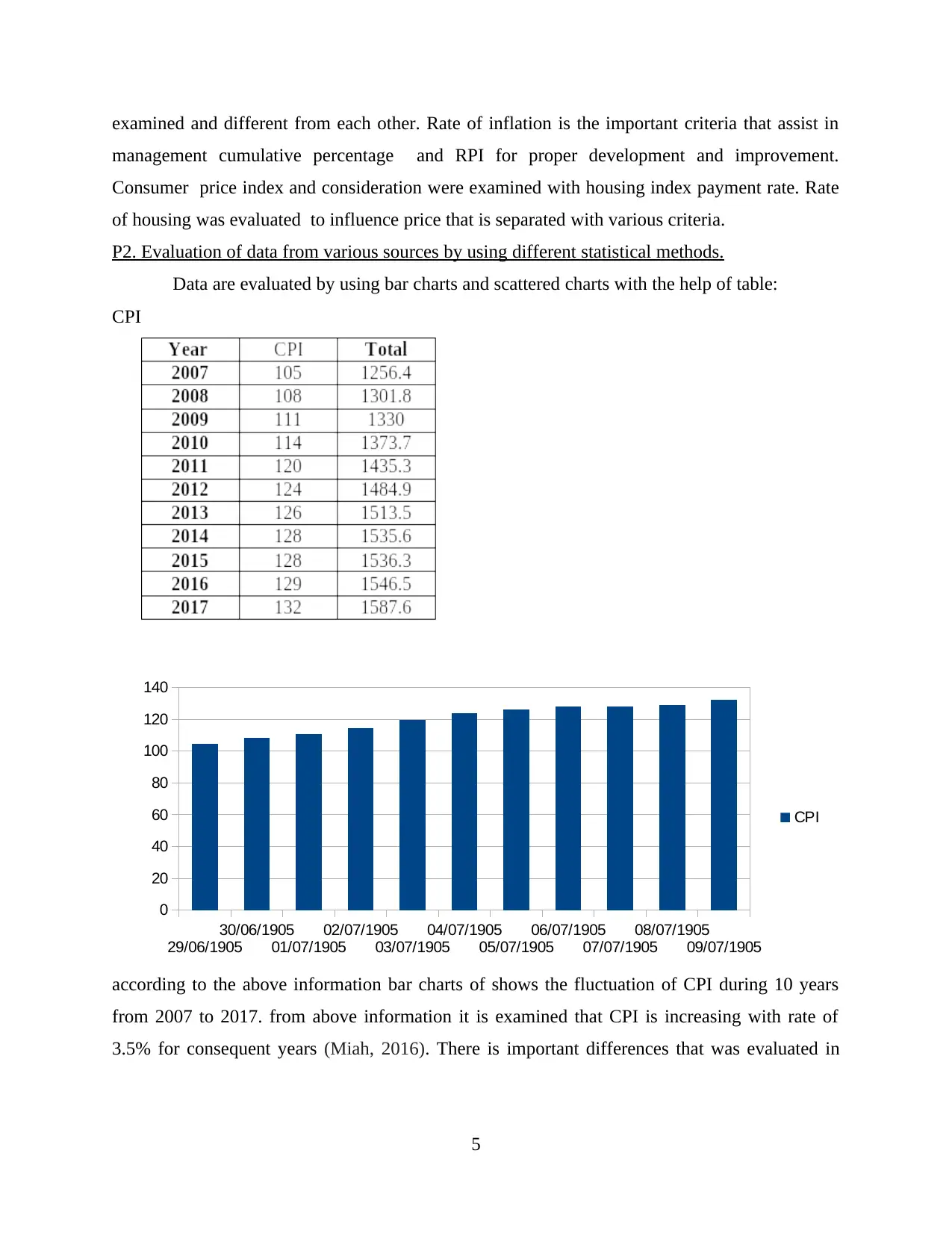
examined and different from each other. Rate of inflation is the important criteria that assist in
management cumulative percentage and RPI for proper development and improvement.
Consumer price index and consideration were examined with housing index payment rate. Rate
of housing was evaluated to influence price that is separated with various criteria.
P2. Evaluation of data from various sources by using different statistical methods.
Data are evaluated by using bar charts and scattered charts with the help of table:
CPI
according to the above information bar charts of shows the fluctuation of CPI during 10 years
from 2007 to 2017. from above information it is examined that CPI is increasing with rate of
3.5% for consequent years (Miah, 2016). There is important differences that was evaluated in
5
29/06/1905
30/06/1905
01/07/1905
02/07/1905
03/07/1905
04/07/1905
05/07/1905
06/07/1905
07/07/1905
08/07/1905
09/07/1905
0
20
40
60
80
100
120
140
CPI
management cumulative percentage and RPI for proper development and improvement.
Consumer price index and consideration were examined with housing index payment rate. Rate
of housing was evaluated to influence price that is separated with various criteria.
P2. Evaluation of data from various sources by using different statistical methods.
Data are evaluated by using bar charts and scattered charts with the help of table:
CPI
according to the above information bar charts of shows the fluctuation of CPI during 10 years
from 2007 to 2017. from above information it is examined that CPI is increasing with rate of
3.5% for consequent years (Miah, 2016). There is important differences that was evaluated in
5
29/06/1905
30/06/1905
01/07/1905
02/07/1905
03/07/1905
04/07/1905
05/07/1905
06/07/1905
07/07/1905
08/07/1905
09/07/1905
0
20
40
60
80
100
120
140
CPI
Paraphrase This Document
Need a fresh take? Get an instant paraphrase of this document with our AI Paraphraser
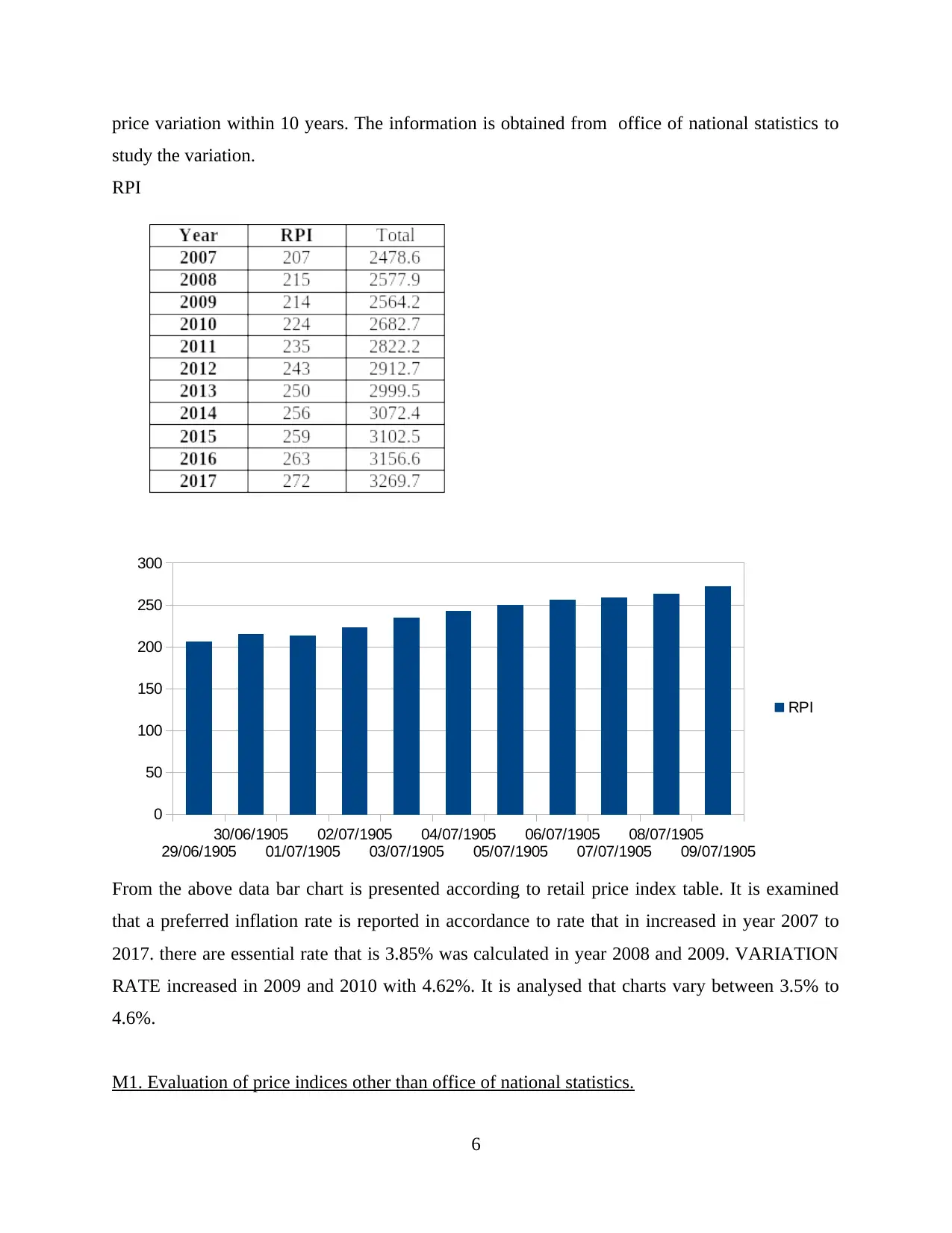
price variation within 10 years. The information is obtained from office of national statistics to
study the variation.
RPI
From the above data bar chart is presented according to retail price index table. It is examined
that a preferred inflation rate is reported in accordance to rate that in increased in year 2007 to
2017. there are essential rate that is 3.85% was calculated in year 2008 and 2009. VARIATION
RATE increased in 2009 and 2010 with 4.62%. It is analysed that charts vary between 3.5% to
4.6%.
M1. Evaluation of price indices other than office of national statistics.
6
29/06/1905
30/06/1905
01/07/1905
02/07/1905
03/07/1905
04/07/1905
05/07/1905
06/07/1905
07/07/1905
08/07/1905
09/07/1905
0
50
100
150
200
250
300
RPI
study the variation.
RPI
From the above data bar chart is presented according to retail price index table. It is examined
that a preferred inflation rate is reported in accordance to rate that in increased in year 2007 to
2017. there are essential rate that is 3.85% was calculated in year 2008 and 2009. VARIATION
RATE increased in 2009 and 2010 with 4.62%. It is analysed that charts vary between 3.5% to
4.6%.
M1. Evaluation of price indices other than office of national statistics.
6
29/06/1905
30/06/1905
01/07/1905
02/07/1905
03/07/1905
04/07/1905
05/07/1905
06/07/1905
07/07/1905
08/07/1905
09/07/1905
0
50
100
150
200
250
300
RPI
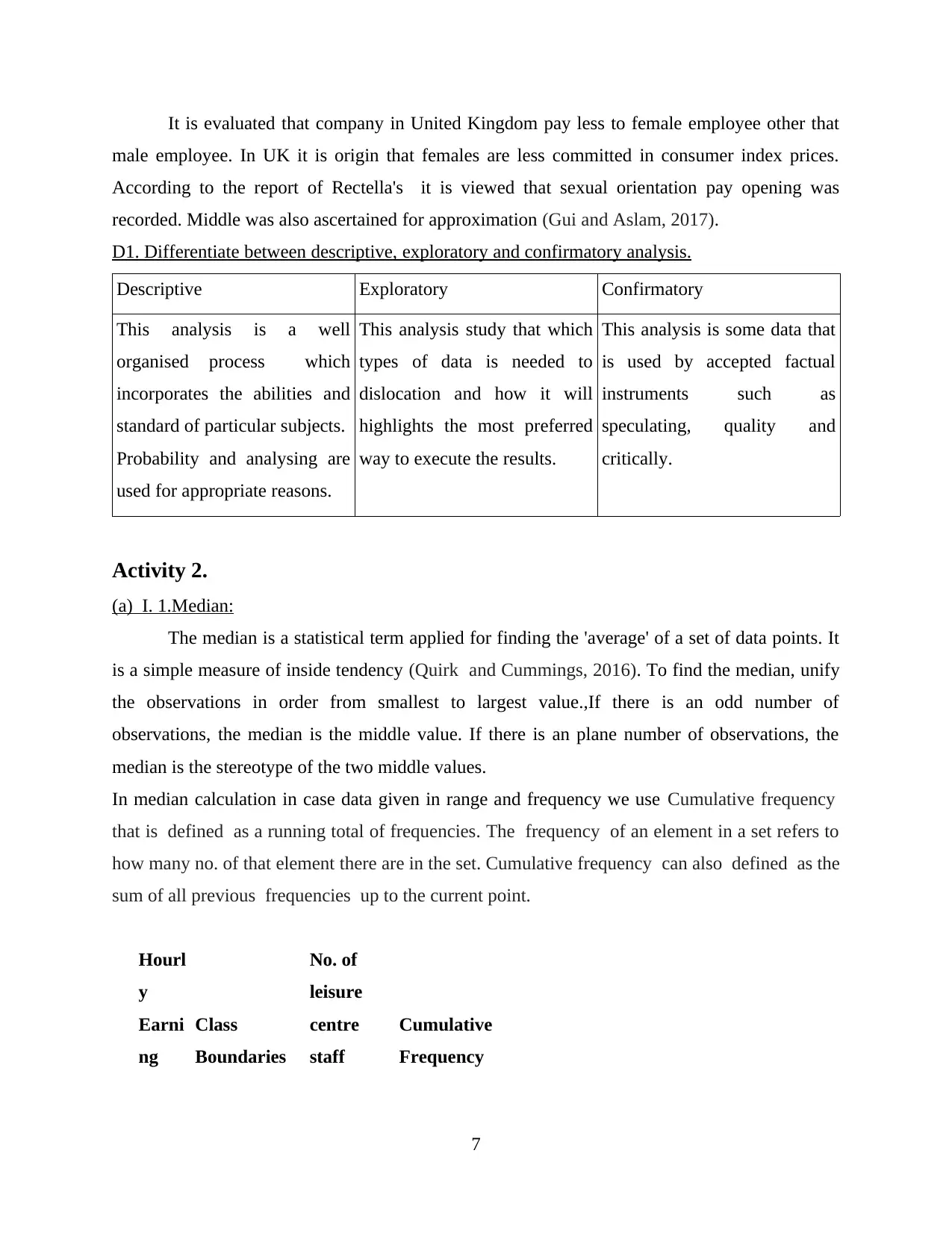
It is evaluated that company in United Kingdom pay less to female employee other that
male employee. In UK it is origin that females are less committed in consumer index prices.
According to the report of Rectella's it is viewed that sexual orientation pay opening was
recorded. Middle was also ascertained for approximation (Gui and Aslam, 2017).
D1. Differentiate between descriptive, exploratory and confirmatory analysis.
Descriptive Exploratory Confirmatory
This analysis is a well
organised process which
incorporates the abilities and
standard of particular subjects.
Probability and analysing are
used for appropriate reasons.
This analysis study that which
types of data is needed to
dislocation and how it will
highlights the most preferred
way to execute the results.
This analysis is some data that
is used by accepted factual
instruments such as
speculating, quality and
critically.
Activity 2.
(a) I. 1.Median:
The median is a statistical term applied for finding the 'average' of a set of data points. It
is a simple measure of inside tendency (Quirk and Cummings, 2016). To find the median, unify
the observations in order from smallest to largest value.,If there is an odd number of
observations, the median is the middle value. If there is an plane number of observations, the
median is the stereotype of the two middle values.
In median calculation in case data given in range and frequency we use Cumulative frequency
that is defined as a running total of frequencies. The frequency of an element in a set refers to
how many no. of that element there are in the set. Cumulative frequency can also defined as the
sum of all previous frequencies up to the current point.
Hourl
y
Earni
ng
Class
Boundaries
No. of
leisure
centre
staff
Cumulative
Frequency
7
male employee. In UK it is origin that females are less committed in consumer index prices.
According to the report of Rectella's it is viewed that sexual orientation pay opening was
recorded. Middle was also ascertained for approximation (Gui and Aslam, 2017).
D1. Differentiate between descriptive, exploratory and confirmatory analysis.
Descriptive Exploratory Confirmatory
This analysis is a well
organised process which
incorporates the abilities and
standard of particular subjects.
Probability and analysing are
used for appropriate reasons.
This analysis study that which
types of data is needed to
dislocation and how it will
highlights the most preferred
way to execute the results.
This analysis is some data that
is used by accepted factual
instruments such as
speculating, quality and
critically.
Activity 2.
(a) I. 1.Median:
The median is a statistical term applied for finding the 'average' of a set of data points. It
is a simple measure of inside tendency (Quirk and Cummings, 2016). To find the median, unify
the observations in order from smallest to largest value.,If there is an odd number of
observations, the median is the middle value. If there is an plane number of observations, the
median is the stereotype of the two middle values.
In median calculation in case data given in range and frequency we use Cumulative frequency
that is defined as a running total of frequencies. The frequency of an element in a set refers to
how many no. of that element there are in the set. Cumulative frequency can also defined as the
sum of all previous frequencies up to the current point.
Hourl
y
Earni
ng
Class
Boundaries
No. of
leisure
centre
staff
Cumulative
Frequency
7
⊘ This is a preview!⊘
Do you want full access?
Subscribe today to unlock all pages.

Trusted by 1+ million students worldwide
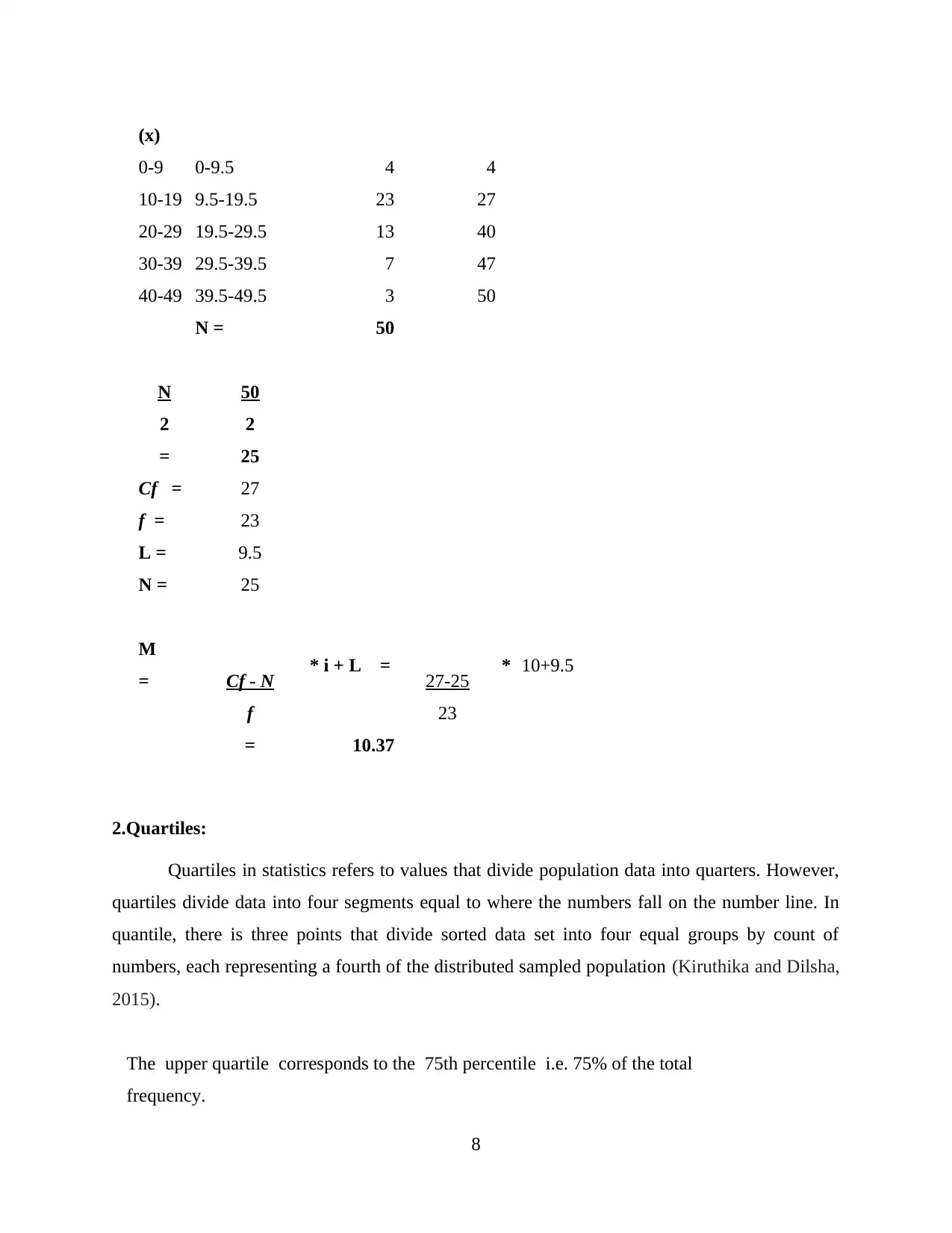
(x)
0-9 0-9.5 4 4
10-19 9.5-19.5 23 27
20-29 19.5-29.5 13 40
30-39 29.5-39.5 7 47
40-49 39.5-49.5 3 50
N = 50
N 50
2 2
= 25
Cf = 27
f = 23
L = 9.5
N = 25
M
= Cf - N * i + L = 27-25 * 10+9.5
f 23
= 10.37
2.Quartiles:
Quartiles in statistics refers to values that divide population data into quarters. However,
quartiles divide data into four segments equal to where the numbers fall on the number line. In
quantile, there is three points that divide sorted data set into four equal groups by count of
numbers, each representing a fourth of the distributed sampled population (Kiruthika and Dilsha,
2015).
The upper quartile corresponds to the 75th percentile i.e. 75% of the total
frequency.
8
0-9 0-9.5 4 4
10-19 9.5-19.5 23 27
20-29 19.5-29.5 13 40
30-39 29.5-39.5 7 47
40-49 39.5-49.5 3 50
N = 50
N 50
2 2
= 25
Cf = 27
f = 23
L = 9.5
N = 25
M
= Cf - N * i + L = 27-25 * 10+9.5
f 23
= 10.37
2.Quartiles:
Quartiles in statistics refers to values that divide population data into quarters. However,
quartiles divide data into four segments equal to where the numbers fall on the number line. In
quantile, there is three points that divide sorted data set into four equal groups by count of
numbers, each representing a fourth of the distributed sampled population (Kiruthika and Dilsha,
2015).
The upper quartile corresponds to the 75th percentile i.e. 75% of the total
frequency.
8
Paraphrase This Document
Need a fresh take? Get an instant paraphrase of this document with our AI Paraphraser
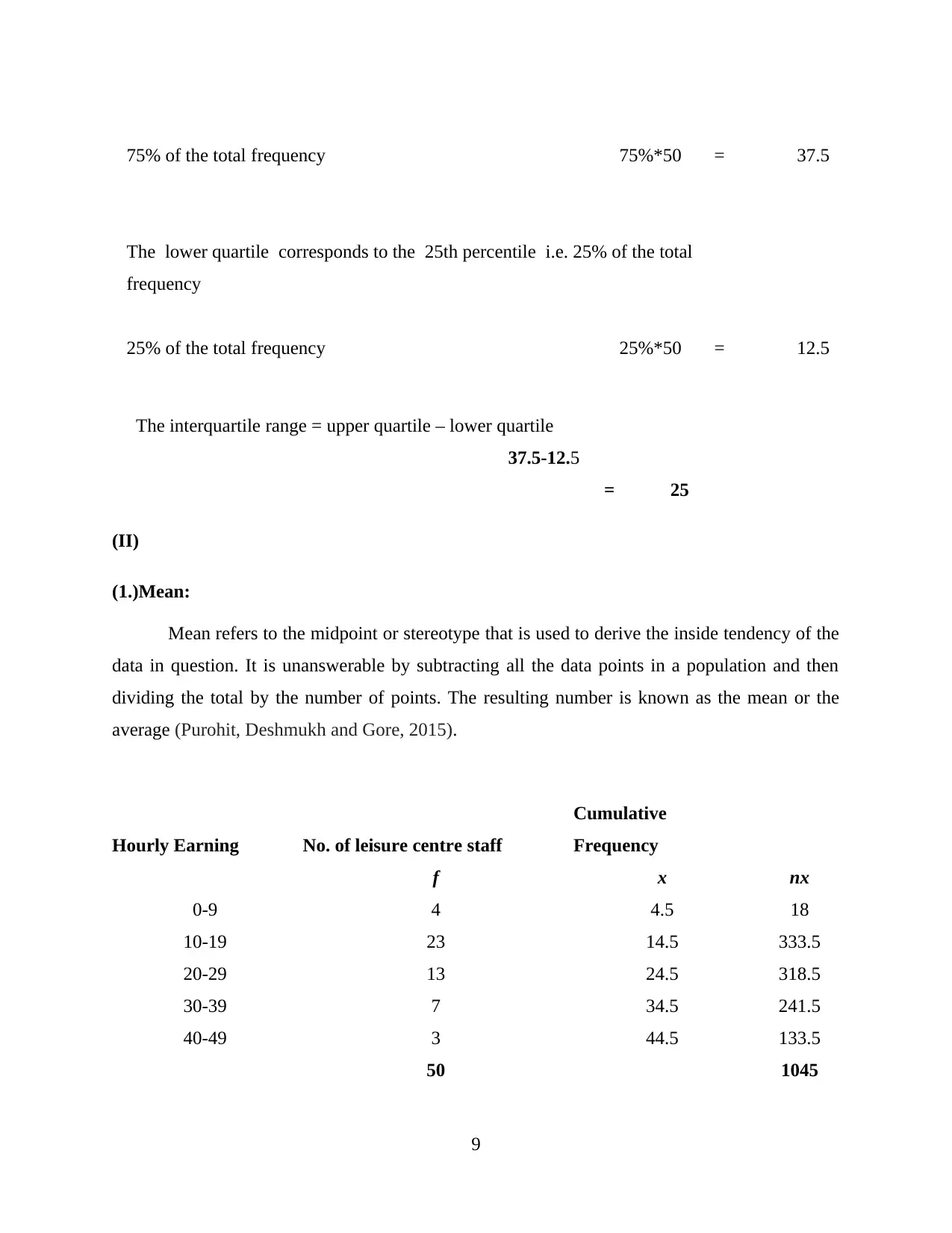
75% of the total frequency 75%*50 = 37.5
The lower quartile corresponds to the 25th percentile i.e. 25% of the total
frequency
25% of the total frequency 25%*50 = 12.5
The interquartile range = upper quartile – lower quartile
37.5-12.5
= 25
(II)
(1.)Mean:
Mean refers to the midpoint or stereotype that is used to derive the inside tendency of the
data in question. It is unanswerable by subtracting all the data points in a population and then
dividing the total by the number of points. The resulting number is known as the mean or the
average (Purohit, Deshmukh and Gore, 2015).
Hourly Earning No. of leisure centre staff
Cumulative
Frequency
f x nx
0-9 4 4.5 18
10-19 23 14.5 333.5
20-29 13 24.5 318.5
30-39 7 34.5 241.5
40-49 3 44.5 133.5
50 1045
9
The lower quartile corresponds to the 25th percentile i.e. 25% of the total
frequency
25% of the total frequency 25%*50 = 12.5
The interquartile range = upper quartile – lower quartile
37.5-12.5
= 25
(II)
(1.)Mean:
Mean refers to the midpoint or stereotype that is used to derive the inside tendency of the
data in question. It is unanswerable by subtracting all the data points in a population and then
dividing the total by the number of points. The resulting number is known as the mean or the
average (Purohit, Deshmukh and Gore, 2015).
Hourly Earning No. of leisure centre staff
Cumulative
Frequency
f x nx
0-9 4 4.5 18
10-19 23 14.5 333.5
20-29 13 24.5 318.5
30-39 7 34.5 241.5
40-49 3 44.5 133.5
50 1045
9
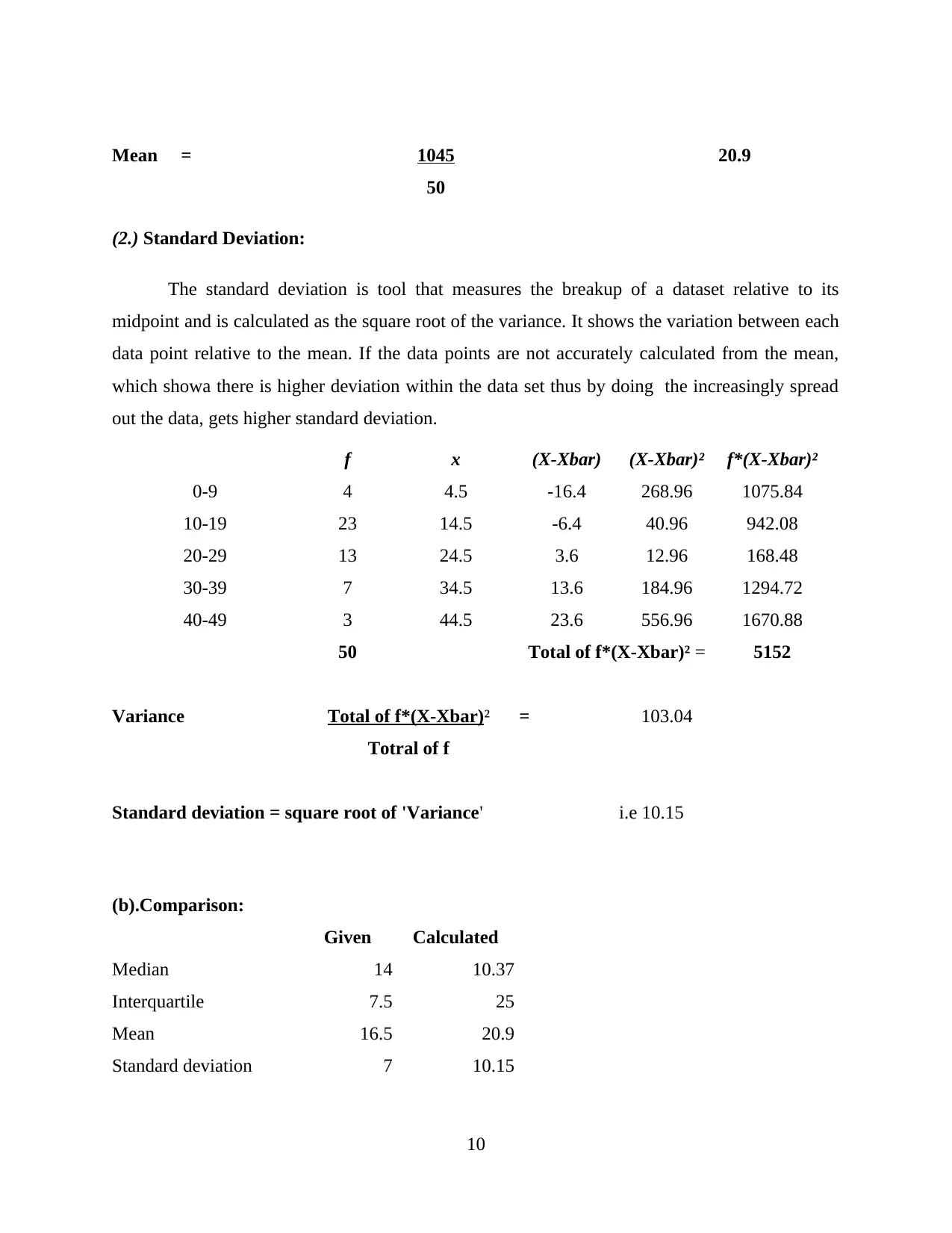
Mean = 1045 20.9
50
(2.) Standard Deviation:
The standard deviation is tool that measures the breakup of a dataset relative to its
midpoint and is calculated as the square root of the variance. It shows the variation between each
data point relative to the mean. If the data points are not accurately calculated from the mean,
which showa there is higher deviation within the data set thus by doing the increasingly spread
out the data, gets higher standard deviation.
f x (X-Xbar) (X-Xbar)² f*(X-Xbar)²
0-9 4 4.5 -16.4 268.96 1075.84
10-19 23 14.5 -6.4 40.96 942.08
20-29 13 24.5 3.6 12.96 168.48
30-39 7 34.5 13.6 184.96 1294.72
40-49 3 44.5 23.6 556.96 1670.88
50 Total of f*(X-Xbar)² = 5152
Variance Total of f*(X-Xbar)² = 103.04
Totral of f
Standard deviation = square root of 'Variance' i.e 10.15
(b).Comparison:
Given Calculated
Median 14 10.37
Interquartile 7.5 25
Mean 16.5 20.9
Standard deviation 7 10.15
10
50
(2.) Standard Deviation:
The standard deviation is tool that measures the breakup of a dataset relative to its
midpoint and is calculated as the square root of the variance. It shows the variation between each
data point relative to the mean. If the data points are not accurately calculated from the mean,
which showa there is higher deviation within the data set thus by doing the increasingly spread
out the data, gets higher standard deviation.
f x (X-Xbar) (X-Xbar)² f*(X-Xbar)²
0-9 4 4.5 -16.4 268.96 1075.84
10-19 23 14.5 -6.4 40.96 942.08
20-29 13 24.5 3.6 12.96 168.48
30-39 7 34.5 13.6 184.96 1294.72
40-49 3 44.5 23.6 556.96 1670.88
50 Total of f*(X-Xbar)² = 5152
Variance Total of f*(X-Xbar)² = 103.04
Totral of f
Standard deviation = square root of 'Variance' i.e 10.15
(b).Comparison:
Given Calculated
Median 14 10.37
Interquartile 7.5 25
Mean 16.5 20.9
Standard deviation 7 10.15
10
⊘ This is a preview!⊘
Do you want full access?
Subscribe today to unlock all pages.

Trusted by 1+ million students worldwide
1 out of 21
Related Documents
Your All-in-One AI-Powered Toolkit for Academic Success.
+13062052269
info@desklib.com
Available 24*7 on WhatsApp / Email
![[object Object]](/_next/static/media/star-bottom.7253800d.svg)
Unlock your academic potential
Copyright © 2020–2025 A2Z Services. All Rights Reserved. Developed and managed by ZUCOL.





